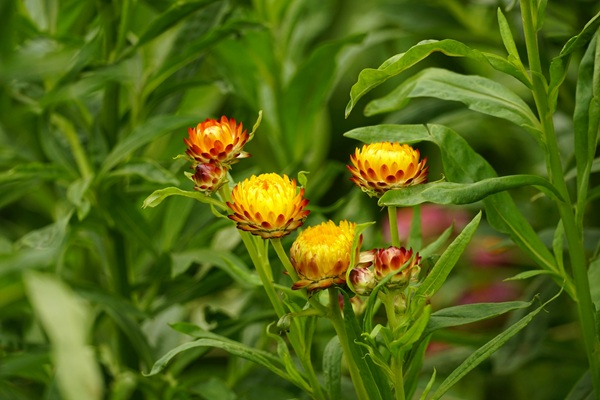
As summer is winding down and fall approaches, your thoughts may turn to mums, asters, and pansies. Consider changing things up this year by adding deer-resistant strawflowers to your late summer and fall containers and gardens.
Grow strawflowers (Xerochrysum bracteatum formerly Bracteantha) in full to part sun and moist well-drained soil. They are heat and cold tolerant, grown as annuals in most areas, and short-lived perennials in zones 8 to 10. You’ll enjoy continuous blooming and visiting pollinators from spring through summer and into fall until frost. Plant some now to replace fading summer annuals, freshen up your late season garden or create fall containers. The range of flower colors makes them easy to include in your late season displays.
Plant strawflowers in the garden or a container with drainage holes and fill with a quality potting mix. Select a pot, at least 12” in diameter to avoid the plant becoming rootbound and drying out too quickly. Although the flowers look dry, the plants prefer moist well-drained soil. Check containers daily and water thoroughly as needed. Those growing in the garden should be watered thoroughly when the top few inches of soil are crumbly and moist.
Strawflowers unique blossoms look and feel dry to the touch, making them extra fun for kids to grow. This straw-like texture of the flowers inspired the common name. You may also hear them referred to as everlasting flowers since they don’t wilt readily when picked and retain their shape and color for years once dried.
Set a pot of colorful strawflowers among your pumpkins, ornamental squash and other fall décor. Combine them in containers and garden beds with other fall favorites like ornamental kale and cabbage, grasses, ornamental peppers, pansies, calibrachoas, and more.
Grow plenty so you’ll have enough to enjoy as cut flowers and even more to dry for crafting wreaths, garland, flower spheres, and adding to dried arrangements. Harvest flowers when two to three layers of the petal-like bracts have unfolded but the center is still tightly closed. The flower will continue to open as it dries so waiting too long results in a more open bloom. Harvest regularly to encourage even more flowers.
Recut the stem at an angle and place the strawflower in fresh water and condition in a cool dark place for a few hours or overnight when using in fresh arrangements.
Hang the stems in bundles upside down in a warm dry place when preserving them dried. You may opt to remove the stem and replace it with florist wire if you plan on using the dried strawflowers in a wreath or an arrangement where a stem is needed. As the flower dries, it secures the wire in place. Remove the flowers from the stems once dried if you plan on using just the flowers in crafting projects.
Discover the beauty and many uses of strawflowers this fall. Then, plan on starting out next season growing even more to enjoy all season long.
Melinda Myers has written more than 20 gardening books, including Small Space Gardening. She hosts the “How to Grow Anything” DVD series and the Melinda’s Garden Moment TV & radio segments. Her website is MelindaMyers.com.



Comment here